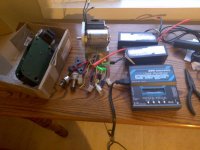ls7corvete
1 W
Well I have a kepler Mk1 drive on the way. I am also in the process of ordering a Commuter booster. I am excited to put these things together but now I am stuck on what controller and what batteries to get.
For the controller I was planning on just getting a small and inexpensive sensorless controller (Lyen or winderness energy). But now I am wondering if I should get something that could be put on a more powerful bike in the future?
For batteries, I want 36v so I can use a ebike controller instead of a RC speed control. I cant decide between the 10s Lipo and 2x 6s LiFePO4. I havent found a charger for either of them I am happy about. Hardcase batteries are attractive but I cant figure out a way to make a 36v pack with between 5-8ah (I want a small pack to start with, I will double up later if I need).
What do you guys think?
I will be using this for short trips around town, 5-10 miles mostly. Always pedaling, I just want to get my speed up to between 20-25mph on the flats
Kepler eboost Mk1 drives for sale.
http://endless-sphere.com/forums/viewtopic.php?f=9&t=32035
Commuter Booster drive units.
http://endless-sphere.com/forums/viewtopic.php?f=31&t=34586
C6374-180kv Brushless Outrunner Motor.
http://www.hobbyking.com/hobbyking/store/__13975__C6374_180kv_Brushless_Outrunner_Motor.html
Turnigy 4500mAh 6S2P 30C LiFePo4 Pack
http://www.hobbyking.com/hobbyking/store/__10311__Turnigy_4500mAh_6S2P_30C_LiFePo4_Pack.html
Turnigy nano-tech 5000mah 10S 25~50C Lipo Pack
http://www.hobbyking.com/hobbyking/store/__14609__Turnigy_nano_tech_5000mah_10S_25_50C_Lipo_Pack.html
For the controller I was planning on just getting a small and inexpensive sensorless controller (Lyen or winderness energy). But now I am wondering if I should get something that could be put on a more powerful bike in the future?
For batteries, I want 36v so I can use a ebike controller instead of a RC speed control. I cant decide between the 10s Lipo and 2x 6s LiFePO4. I havent found a charger for either of them I am happy about. Hardcase batteries are attractive but I cant figure out a way to make a 36v pack with between 5-8ah (I want a small pack to start with, I will double up later if I need).
What do you guys think?
I will be using this for short trips around town, 5-10 miles mostly. Always pedaling, I just want to get my speed up to between 20-25mph on the flats
Kepler eboost Mk1 drives for sale.
http://endless-sphere.com/forums/viewtopic.php?f=9&t=32035
Commuter Booster drive units.
http://endless-sphere.com/forums/viewtopic.php?f=31&t=34586
C6374-180kv Brushless Outrunner Motor.
http://www.hobbyking.com/hobbyking/store/__13975__C6374_180kv_Brushless_Outrunner_Motor.html
Turnigy 4500mAh 6S2P 30C LiFePo4 Pack
http://www.hobbyking.com/hobbyking/store/__10311__Turnigy_4500mAh_6S2P_30C_LiFePo4_Pack.html
Turnigy nano-tech 5000mah 10S 25~50C Lipo Pack
http://www.hobbyking.com/hobbyking/store/__14609__Turnigy_nano_tech_5000mah_10S_25_50C_Lipo_Pack.html



